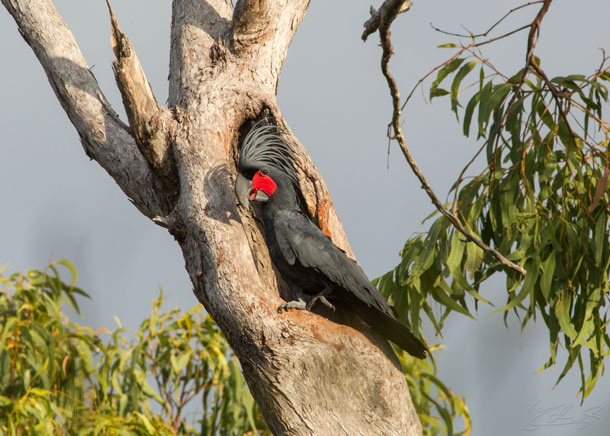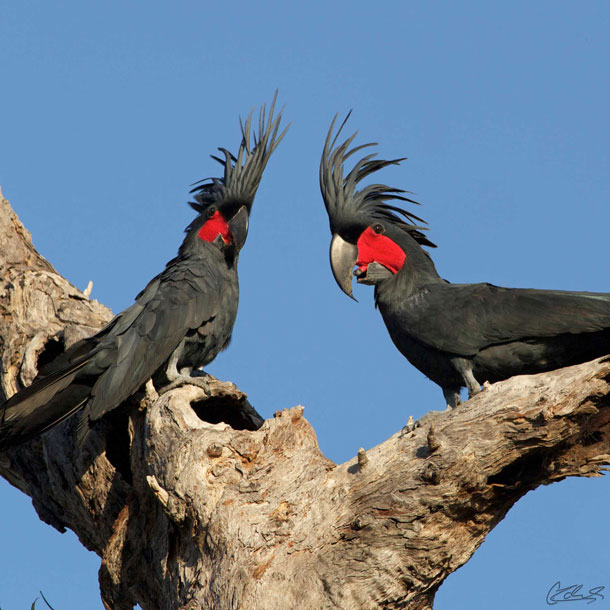BirdNote®: Palm Cockatoo Gets The Girl
Air Date: Week of February 1, 2019

The adult palm cockatoo can grow up to two feet in length. (Photo: © Christina Zdenek)
The Australian Palm Cockatoo’s mating ritual involves using sticks -- as drumsticks! The rhythmic beats they make are the first documented instance of an animal using a tool to make music. BirdNote’s Mary McCann has the story on these percussive birds.
Transcript
CURWOOD: We stay in the Land Down Under to bring you a unique way to pick up a mate. BirdNote’s Mary McCann explains that a male Australian Palm Cockatoo uses much more than just his voice to make seductive music.
BirdNote®
Palm Cockatoo Gets the Girl
In the music world, it’s often said that the drummer never gets the girl.
[Palm Cockatoo screech]
But is this true? Maybe not for wild Australian Palm Cockatoos.
[Palm Cockatoo screech, then drumming and Australian ambient throughout]
For the first time, ever, an animal has been documented making a tool to create music. Male Palm Cockatoos use their enormous beaks to break off a stick or seed pod from a tree. The bird then fashions it into a sort of drumstick. Clutching the stick in his left foot, he beats on a hollow tree.

The palm cockatoo is one of only a few bird species known to use tools, and possibly the only animal species to use tools specifically to make music. (Photo: © Christina Zdenek)
Most animals that use tools do so to get food. But these cockatoos seem to do it specifically to create a rhythmic beat designed to impress their potential mates.
Drumming is just part of an intricate courtship display. The male cockatoo sways his body, stretches his wings, and erects his long, slender crest feathers, all the while producing loud, high-pitched whistles. Not only that, but he "blushes" — his bare cheek patches turn bright red, contrasting brilliantly with his all-black plumage. As the display continues, he pirouettes on his branch and bobs his head.
If the female watching is impressed, she’ll join the male on his branch and imitate his movements — swaying, bobbing, and whistling alongside him as he drums.
[Palm Cockatoo whistles]
OK, so maybe this drummer does get the girl.
I’m Mary McCann
###
Written by GrrlScientist
Bird sounds provided by The Macaulay Library of Natural Sounds at the Cornell Lab of Ornithology, Ithaca, New York. Recorded by E Grieg ML 201166. Additional bird sounds recorded by Robert Heinsohn and Christina Zdenek.
BirdNote’s theme composed and played by Nancy Rumbel and John Kessler.
Producer: John Kessler; Managing Producer: Jason Saul; Associate Producer: Ellen Blackstone
© 2019 Tune In to Nature.org February 2019 Narrator: Mary McCann
https://www.forbes.com/sites/grrlscientist/2017/06/29/cockatoos-drum-with-the-rhythm-of-love/#452dc0177977
http://www.christinazdenek.com/palm-cockatoo/
https://www.birdnote.org/show/palm-cockatoo-gets-girl
CURWOOD: For pictures, dance on over to our website, loe.org.
Links
Learn more on the BirdNote website
Living on Earth wants to hear from you!
Living on Earth
62 Calef Highway, Suite 212
Lee, NH 03861
Telephone: 617-287-4121
E-mail: comments@loe.org
Newsletter [Click here]
Donate to Living on Earth!
Living on Earth is an independent media program and relies entirely on contributions from listeners and institutions supporting public service. Please donate now to preserve an independent environmental voice.
NewsletterLiving on Earth offers a weekly delivery of the show's rundown to your mailbox. Sign up for our newsletter today!
 Sailors For The Sea: Be the change you want to sea.
Sailors For The Sea: Be the change you want to sea.
 The Grantham Foundation for the Protection of the Environment: Committed to protecting and improving the health of the global environment.
The Grantham Foundation for the Protection of the Environment: Committed to protecting and improving the health of the global environment.
 Contribute to Living on Earth and receive, as our gift to you, an archival print of one of Mark Seth Lender's extraordinary wildlife photographs. Follow the link to see Mark's current collection of photographs.
Contribute to Living on Earth and receive, as our gift to you, an archival print of one of Mark Seth Lender's extraordinary wildlife photographs. Follow the link to see Mark's current collection of photographs.
 Buy a signed copy of Mark Seth Lender's book Smeagull the Seagull & support Living on Earth
Buy a signed copy of Mark Seth Lender's book Smeagull the Seagull & support Living on Earth

